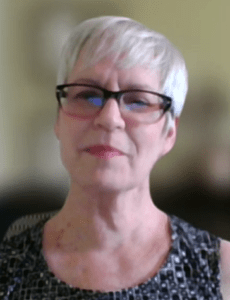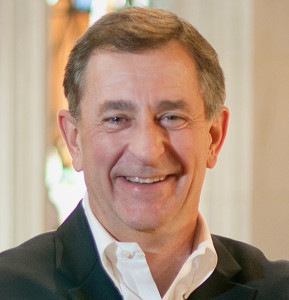While many American churches have returned to in-person gatherings since — or even before — COVID-19 vaccines became widely available earlier this year, others have chosen a slower, more cautious route through the pandemic and are learning some hard lessons as a result.
“We had one family that did not agree with our mask mandate, and they chose to go where masks were not required,” said Judy Fackenthal, co-interim pastor at Garfield Park Baptist Church in Indianapolis.
That was in the spring when the small downtown congregation initially returned to in-person worship with masking and social distancing requirements.

Judy Fackenthal
But the pressure to fully re-open preceded the vaccines. “We had a couple people say, ‘Why are we outdoors? Why can’t we go back in? Why are we not trusting God? If God is with us, isn’t God going to protect us?” Fackenthal said.
“I wanted to be very careful not to offend people’s theological positions, but I would say something like I trust that God has given scientists an amazing ability to learn and discern the safest practices for us in this pandemic, and therefore we are going to trust what the scientists say,” she said earlier this month. “And as of a month ago, or shortly after, our board met and decided that the fully vaccinated do not need to wear a mask in worship.”
The congregation of First Baptist Church of Worchester, Mass., has yet to return to indoor services, opting instead for outdoor gatherings with no masks required for the vaccinated. So far, the response has been positive.
“We don’t want to lose a congregant to this virus,” said Pastor Brent Newberry. “I don’t want to let up now, and I don’t think anyone is making a push for that. Everyone seems quite fine to bring a mask and put it on if it means we can see each other.”

Brent Newberry
But Newberry added that having to continually weigh the options is one of the more challenging aspects of the pandemic, especially given the ongoing resurgence of cases nationally.
“I always convey to my congregation that there are two certainties: the situation will continue to change, and we will keep adapting, and we will be flexible and supportive throughout the process.”
The situations requiring adaptation are seemingly endless, experts say, as the pandemic has challenged everything from the viability of buildings, the shape of future online worship, the definition of church membership, staffing needs and even the meaning of church as a whole.
And whatever the question, the overall answer is that there is no returning to pre-COVID church life, said Mark Tidsworth, a clergy and congregational consultant and founder of Pinnacle Leadership Associates.
“This period of church life is raising questions that churches never had before, and that’s the adaptive opportunity in this situation,” he said. “How does our faith tradition guide us here? Churches are doing a lot of sorting through theology, faith and practice and trying to figure out where God is in this moment in time in the Christian movement in this world.”
One of the more perplexing challenges for Garfield Park Baptist has been navigating the relationship between virtual and in-person programming since in-person worship resumed on Easter this year, Fackenthal said.
Some members who live near the church have opted to keep worshiping online instead of returning to the pews, she reported. “That’s something I think pastors are wrestling with, that folks are very comfortable, now, worshipping in their homes on Sunday and so they will keep doing that.”
Some members who live near the church have opted to keep worshiping online instead of returning to the pews.
It’s not as easy as just turning off the livestream, she added, because people from around the world have become attached to the virtual services during the pandemic.
“That creates some ecclesial and theological questions: What do people really see is the purpose of worship? What drives people to worship, anyway? Is it about the gathered body coming together for corporate worship? And doesn’t that beg some questions about what the purpose of the church is and whether we have gotten too attached to our buildings?”
Other challenges remain, including the current surge in the Delta variant of COVID-19 cases that may necessitate a return to mask wearing, she added. “People are now conformable not wearing a mask. It is going to be hard if we have to ask them to wear a mask again.”
But the pluses outweigh the minuses, Fackenthal said. “I think this is an opportunity for the church to reconfigure and to look back at Scripture for what it means to be the church.”

Mark Tidsworth
Churches also are redefining what membership entails, Tidsworth said. He cited one church that created a “distance member” category, while another is calling them “virtual disciples.” Both come with expectations and responsibilities for membership.
“The nice side effect here is that the church has to consider what membership means. It’s forcing churches to reflect on what they believe it means to be a part of a church community, and members are thinking about that, too.”
Many churches also are trying to discern the benefit of owning facilities that are not refilling to capacity — and likely weren’t full before the pandemic, either, said Bill Wilson, founder and director of the Center for Healthy Churches.

Bill Wilson
Unofficial estimates indicate that only a quarter to a third of U.S. congregants have come back since churches have opened their doors. Those who attended 45 or more Sundays a year pre-pandemic are expected to attend only 25 to 30 times annually going forward, while those who worshipped 12 to 15 times a year will likely move fully online for their church experience, Wilson said.
“That has jolted many to realize they have a lot more building than they have people, and to question how they will manage the expense of that, and what is the stewardship of having rooms and wings that are empty.”
Churches also are increasingly reconsidering staffing decisions in a post-pandemic age by looking at whether they are staffed for the 2010 decade or the 2020s and beyond, with the latter including ministers focused on serving virtual participants, he added.
“Every church needs to think of having a position that is exclusively devoted to the online community. The savvy churches are not looking at online folks as second-class citizens but as a rich opportunity to engage people who would never set foot in that church otherwise.”
Related articles:
Don’t expect churches to return to ‘normal’ after pandemic
12 trends for being church in a post-pandemic world | Opinion by Barry Howard
How will your church rebuild after the disaster of the past year and a half? | Opinion by Mark Wingfield


